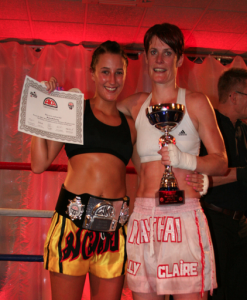 Along the dust-choked battlefields of central Thailand, men once fought murderous wars in defense of their territories. Beside them, brandishing the same long-handled swords stood kunying Mae Yamo, Thailand’s first women warriors. Although we don’t know how many or how often females took up arms with their male kin, legend tells of women answering the call to battle in times of great need.
Along the dust-choked battlefields of central Thailand, men once fought murderous wars in defense of their territories. Beside them, brandishing the same long-handled swords stood kunying Mae Yamo, Thailand’s first women warriors. Although we don’t know how many or how often females took up arms with their male kin, legend tells of women answering the call to battle in times of great need.
With the advent of fire power, such fight skills became dangerous and obsolete. But the support for the arts of war did not die among the Thais and their unique style of combat was eventually transformed into a spectator sport. Between that time and this, the sport, now called muaythai, became a male-only affair and while there have been periodic incidents of women in the ring during the intervening years, nak muay ying or female fighters, had mostly faded from history.
Today muaythai is considered the country’s national sport. Loved by many, it can be seen regularly on Thai TV and in stadiums throughout the country. Prior to the 1970s, however, it was almost unheard of outside the region. With western exploration of Southeast Asia during the Viet Nam era, G.I.s and others finally discovered Thailand’s secret. Foreign trailblazers who first sought training in muaythai faced great challenges simply to learn the art’s most basic techniques. Both competitors and coaches often treated western interlopers with suspicion, or curiosity at best. “Back in the 70’s the Thai’s kept the secrets of muaythai to themselves” claims Patrick Cusick, a native Australian and one of the art’s earlier western practitioners. While he did manage to learn a few fundamental techniques, he stresses that, “they never really taught me the tricks.”
But Cusick and many others eventually did learn, and as more western men gained knowledge and confidence in the art, they brought it home with them and began teaching others. In the 1970s, Thai master instructors also started teaching and promoting their country’s pride abroad and it wasn’t long before western women were showing up at gyms and boxing facilities to learn.
In the kingdom, the 1960s and 70s was hit by the first waves of gender-role changes. Thailand’s biggest muaythai stadiums, Lumphini and Radjadaemnern, hosted a series of female bouts. But the Thai’s resistance to girls in the ring was immediately evident. The virtually all-male audience simply refused to watch or – more importantly – bet on the bouts. What began as a hopeful expansion of the sport to include the entire population was quickly scrapped, with the few aspiring female athlete returning to their traditional domestic duties.
The Thai conflict over women in the fight ring continues to this day, but is in steady decline. The objection stems in part from pre-Buddhist spirit worship beliefs in which the presence of females on the all-male altar of pugilism was thought to be an affront to the spirits of place. In the late 1970s this suspicion and fear was compounded by an incident at Radjadaemnern Stadium. Following a female TV producer’s presence in the ring, every fight that night ended with at least one competitor suffering serious cuts and injuries. What ensued was a near total ban on female fighting throughout Thailand.
